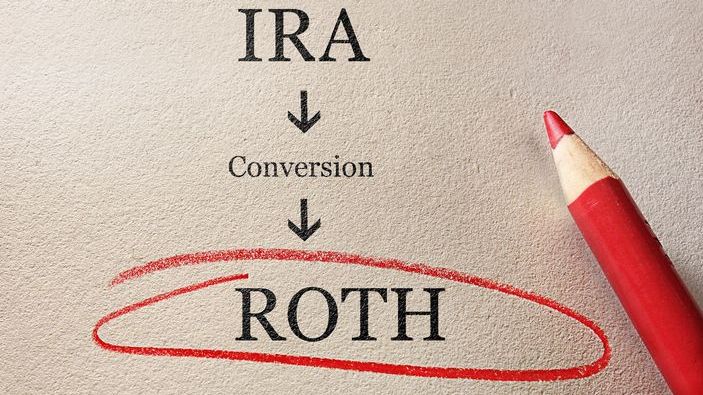There’s no way to entirely avoid paying income taxes when you convert a traditional IRA into a Roth account. However, with smart financial planning you can reduce the impact of those taxes.
By converting your portfolio in segments rather than all at once, you can keep your taxable income down and avoid entering a higher tax bracket. This, in turn, can reduce the amount that you pay on each dollar that’s converted over time.
Say that you have $845,000 in a traditional IRA that you want to convert into a Roth IRA while also reducing the tax hit on the conversion. Here’s how you could think about it.
What Is a Roth Conversion?

There are, generally speaking, two types of tax-advantaged retirement accounts: pre-tax and post-tax.
Pre-tax accounts, such as 401(k)s and traditional IRAs, offer a tax deduction at the time of investment. Each year you can invest up to the annual IRS contribution limit and pay no taxes on that money, making it cheaper to save more. Then, in retirement, you pay income taxes on all withdrawals (including the original contributions).
Post-tax accounts, such as Roth IRAs, offer a tax advantage at the time of withdrawal. Each year you can contribute up to the annual limit with money that you’ve already paid income taxes on. Then, in retirement, you pay no taxes on your withdrawals.
A Roth conversion is when you roll money over from a pre-tax portfolio into a Roth IRA, paying income taxes on the money that you convert. Once you make this conversion, your portfolio will grow and operate according to the rules of a Roth IRA.
Unlike Roth IRA contributions, which are capped at the annual IRA contribution limit ($7,000 in 2024), there is no limit to Roth conversions. You can make as many conversions as you would like each year, in any amount. For example, say you have $845,000 in a traditional IRA. You could convert up to the entire amount in one year or you convert it bit by bit over a number of years.
Anyone approaching retirement should be aware that Roth conversions are subject to a five-year rule: money that’s converted cannot be withdrawn for at least five years (unless you’re 59 ½ or older). Withdrawing any of the converted funds before the cooling off period ends will trigger a 10% early withdrawal penalty. However, a financial advisor can help you determine how and when to do a Roth conversion.
Roth Conversions and Taxes
Tax-free growth is the main advantage of a Roth conversion. Once you move your money to a Roth account and pay the requisite taxes, your balance won’t be taxed. And when you withdraw the money, you won’t pay any taxes on the distributions (provided you adhere to the five-year rule). For this reason, a Roth portfolio also has no required minimum distribution (RMD) requirement, allowing you to leave this money invested indefinitely.
However, the tax-free growth comes at the cost: paying income taxes upfront.
For example, say you convert an $845,000 traditional IRA into a Roth IRA in one lump sum. You would add $845,000 to your taxable income for that year. For an individual filer, even with no other reported income, this would mean facing a 37% marginal tax rate and over $265,000 in federal income taxes.
Households over the age of 59 ½ can take money from their portfolio to pay those taxes, reducing the value of their retirement account. If you are younger, you cannot use your portfolio to pay its own taxes without triggering the 10% penalty. This spares your retirement account, but it requires you to have a potentially significant amount of cash on hand to cover the tax bill. A financial advisor with tax expertise can help you plan for the taxes associated with a Roth conversion.
Managing Roth Conversion Taxes

As you can see, you can’t avoid taxes on a Roth conversion. You can reduce their impact though.
In general, the best way to manage Roth conversion taxes is through planned, staggered conversions. Instead of moving your entire portfolio in one lump sum, you convert it in small, more manageable pieces.
You can structure your conversion around the taxes you’re willing to pay each year. For example, you might set aside $10,000 to pay conversion taxes in a given year, then work backwards to determine the correct amount to meet your savings.
Tax Bracket Management
You can also structure conversions to avoid surging into a higher tax bracket. For example, you can look to “fill up” your current tax bracket each year, being sure that your conversion doesn’t vault you into a higher tax bracket. This can help you keep the income taxes on your conversion as low as possible.
At the same time, you can take advantage of years in which you have less income and a lower marginal tax rate. For most households, it can be helpful to wait until retirement when income and tax rates typically decline. A financial advisor can help you find a Roth conversion strategy that’s suitable for your financial situation.
Roth Conversion Examples
Say that you have $845,000 in a traditional IRA. As we noted above, even without additional income, converting that much money in one lump sum would thrust you into the 37% tax bracket. You could instead make partial, periodic conversions with the goal of filling up your current bracket with additional income from annual conversions.
For example, say that you earn $50,000 per year. In 2024, the tax brackets for individuals are:
- 12%: $11,600 to $47,150
- 22%: $47,150 to $100,525
- 24%: $100,525 to $191,950
- 32%: $191,150 to $243,725
- 35%: $243,725 to $609,350
- 37%: $609,350+
As always with tax brackets, remember that each dollar of income is taxed at the rate of its bracket. So a Roth conversion that increases your marginal tax rate from 24% to 32% doesn’t increase taxes on all of your income, just the converted funds above $191,950.
If you had an annual income of $50,000, you’d be in the 22% tax bracket. So, converting $50,525 per year from your traditional IRA to your Roth IRA would increase your taxable income to $100,525. This fills out the 22% bracket but doesn’t exceed it, and the converted funds would generate $11,115 just in additional taxes (22%).
At this rate, not accounting for portfolio growth, you could convert $845,000 over the course of 16 years. and potentially pay significantly less in income taxes compared to converting a lump sum.
The point is this: The best way to manage your Roth conversion taxes is with a smart conversion schedule. Keeping your rollovers within your current tax bracket each year can go a long way toward minimizing the tax hit of your Roth conversions.
Bottom Line
There’s no way to avoid income taxes on a Roth conversion, but you can keep your marginal tax rate from skyrocketing by doing a series of strategic, partial conversions. Converting just enough each year so that you remain in your current tax bracket can help you avoid increasing your taxes unnecessarily.
Roth Conversion Tips
- Roth IRAs don’t just offer the promise of tax-free income in retirement. They also help you avoid required minimum distributions (RMDs) and the tax bills that come with these mandatory withdrawals that begin at age 73. If you have pre-tax accounts like a traditional IRA or 401(k), calculating your potential RMDs can give you a better sense of what you income and tax situation could look like in retirement.
- A financial advisor can help you build a comprehensive retirement plan. Finding a financial advisor doesn’t have to be hard. SmartAsset’s free tool matches you with up to three vetted financial advisors who serve your area, and you can have a free introductory call with your advisor matches to decide which one you feel is right for you. If you’re ready to find an advisor who can help you achieve your financial goals, get started now.
Photo credit: ©iStock.com/PixelsEffect, ©iStock.com/zimmytws, ©iStock.com/Luke Chan
Read the full article here
















